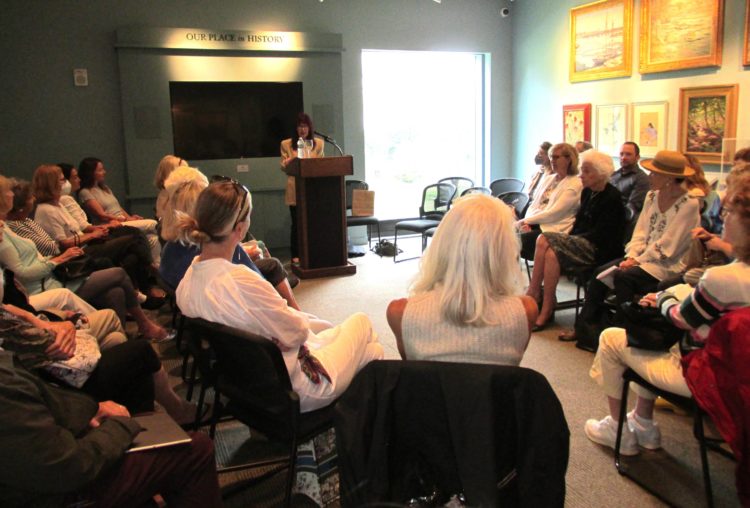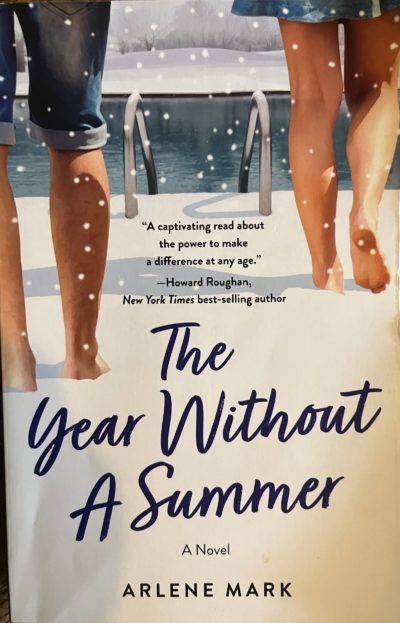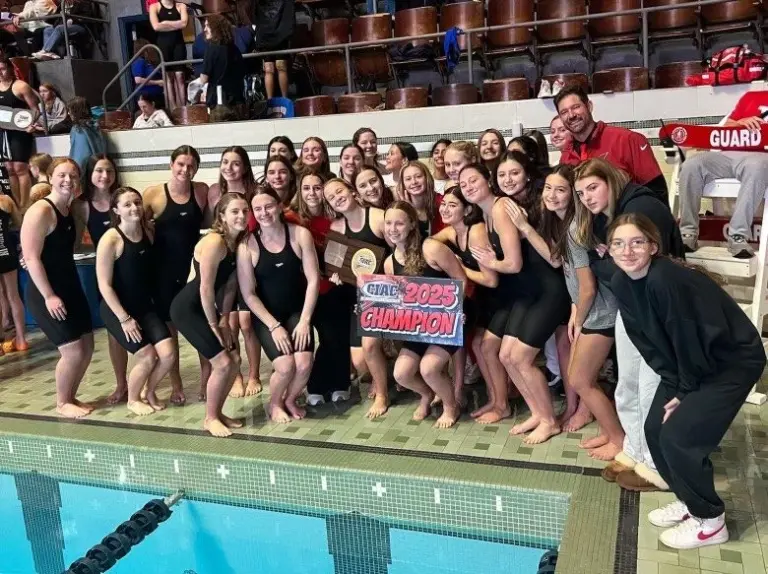On my watch: Arlene Mark launches her YA novel at the Greenwich Historical Society

By Anne W. Semmes
It was remarkable to see that crowd of 40-plus adults at the Greenwich Historical Society, there on a Tavern Garden Market Wednesday to hear Greenwich author Arlene Mark address her new young adult novel, “The Year Without a Summer.” Remarkable because there was no young adult present, but readers aplenty. But Mark has a lot of messages in her book featuring eighth graders, with perhaps her main message that young persons need to be heard in today’s world.
Just how savvy Mark is about young persons was introduced by Debra Mecky, executive director of the Historical Society. “She’s an educational therapist and a school psychologist. She’s a psycho- educator/evaluator for Eagle Hill School. She has her MAT in certified special education and an MAT in education from Manhattanville College…She combines that interest in children in how children think and how children learn to find their work, and she also is inspired by making children smile.”
The story of “The Year Without a Summer” features two eighth graders in school in Albany, N.Y., Clara, an immigrant from hurricane-torn Puerto Rico, and Jamie, obsessed with snowboarding. They take on a science class assignment to debate an historical natural disaster – a major volcanic eruption in 1815 that caused havoc worldwide, and whether it could produce any beneficial results. “Little do Clara and Jamie know how learning about that historical moment will impact their lives,” shares Arlene.
A good take on how the story evolves is given by Arlene’s novelist friend and mine, Jean Moore, in her review on Amazon: “He [Jaime] and classmate Clara tangle at first, but through open minds and growing understanding, they motivate others and learn what it takes to change minds and hearts when it counts. This book takes on big issues, climate change is foremost, and Mark takes the characters through their journeys with compassion and keen insight.”
So, as Arlene began her talk, reading excerpts from her book then commenting on it, this reporter trusted her recording device, as the dialogue unfolding was fascinating, sparked by Arlene’s questions to attendees, and attendee questions for Arlene.
But alas my recording device failed me after the first nine minutes. So, I reached out to some of those attendees for their shares and takeaways!
Bob Arnold, who heads up Family Centers in Greenwich, was impressed, he said, “with Arlene’s remarkable ability to lay out the thinking process of young teenagers. It isn’t linear or neat, but rather bounces around. I used the example of Jamie and the complex relationship he has with his father which at times seemed unidimensional-Bad. Over time and through memories and processing he comes to understand the complexities better. Arlene masterfully lays out the somewhat developmentally simplistic way young teenagers think about some things – her approach rings true.”
Debra Mecky shared how she’d noted, “Arlene seems to identify with the girls in her books, because they are the ones who are courageous and take transformative actions,” as in Arlene’s earlier children’s book, “To the Tower” based on the Tower on Shell Island. “Arlene also said the book she is working on now is all about boys.”

Nancy Burke also heard that message from Arlene, “We need to listen to our young people.” And that, “Girls are way ahead of boys at that [eighth grade] age. Reuben Mark [Arlene’s husband] said girls are way ahead – also when older,” which brought many a smile.
Nancy also liked the Q&A’s. So did this reporter when Arlene asked if anyone remembered their eighth-grade science teacher. A lady in the back had shared, “At Miss Chapin’s School in New York, it was Miss Semmes.” Shelby Semmes was my cousin!
Nancy and others had asked Arlene her writing process. “Arlene said she wrote chapter by chapter each with a beginning, middle and end…and there’s the novel.”
Deborah Weir, a published author, noted how Arlene ‘develops scenes that take the main characters closer to, or farther away from, their goals. This is how she creates literary tension and keeps the reader engaged.”
Deborah enjoyed how, “Arlene read snippets from her book that gave us insight into her characters and developed the conflict between them…She writes about middle schoolers because this was a critical time in her own life, and it remains vivid in her memory.”
So, it does as read in Arlene’s earlier book, “Rescuing Memories,” coauthored by Bebbie Chickering and Judy Crystal. Arlene tells of that early life lived on a farm in Johnstown, Pennsylvania with her parents who had come to America from Ukraine.
Finally, I reached out to Arlene, and she wanted to share again her writing process: “I do write from what’s inside and when it fits, endow my characters with those thoughts or feelings. My ‘process for writing is: First, I write in scenes. Can be one scene per chapter or more. (Only with a scene change, can I change the point of view character.) Each scene must have a beginning, middle, and end. Within that I must know my main character(s) What does she/he/they want? What’s the obstacle to getting it? By the end of the scene, is the main character closer or farther away from the goal? Then move to the next scene or chapter.”
Arlene hopes readers of “A Year Without a Summer” will see how the eighth grade students” are empowered” in their science class. And, importantly, “How does a teacher create the opportunity for them to raise their voices … show that they count?”
And lastly, “At home, how do parents listen to what they might not want to hear and still let their kids know they count….and that maybe, they, the parents count, too? Parents may have not heard that message often. Now it’s time.”




